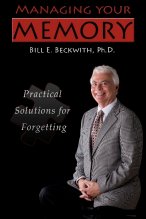What Should I do if I am Risk for Alzheimer’s Disease: Part III
To review from last week, Alzheimer’s disease unfolds over a very long time which gives us an opportunity to develop a comprehensive wellness plan before changes set in. Everyone’s life plan should address the four pillars of long term wellness: advanced directives, financial planning, physical health, and cognitive/memory health. We are fairly good at long term commitment to the first three but many ignore the fourth pillar of wellness: memory and cognitive health.
The foundation of any wellness program is evaluation. Baseline evaluation allows measurement of strengths and weaknesses to allow for development of strategies for enhancing skills. Ongoing evaluations allow feedback on progress and needed refinements in long range goals. Finally, evaluation allows monitoring of changes. Memory evaluations should begin by at least age 50 for anyone with high risk for developing Alzheimer’s disease (e.g., family history, late life depression, head injury of memory loss). Assessments should begin by age 60 for those who do not have such risks as age is the greatest risk factor for development of Alzheimer’s disease.
Memory is assessed and monitored using a challenging learning task – learn a list of words. The list needs to challenge even those with normal memory to be effective. A good memory assessment consists of first learning something new (i.e., a list of words). Second, after learning the list to a preset level (say 5 rehearsals), you are distracted (i.e., given a different list to learn). Finally, you are asked to recall as many words as possible from the first list as measure of strength of short-term memory. Findings are then scored and interpreted (just like blood work) to determine if your memory is as strong as it’s supposed to be for age, sex, and education. The process is repeated over time (just like blood work) to monitor changes over time or to assess effectiveness of treatments (e.g., memory strategies, medications, exercise, mental stimulation).
The most neuroprotective behavior that you can do is to exercise. The formula is simple. Those who are well conditioned do better in their attempts to manage age related diseases such as Alzheimer’s disease, Parkinson/s disease, chronic pain, diabetes, etc. Exercise enhances physical health, reduces depression and anxiety, enhances cerebral blood flow, and increases brain volume. Exercise enhances academic performance in the young, aids stroke recovery, enhances memory and executive functioning, strengthens bones, and decreases risk of falls. Cognitive benefits are gained after as little at 3 months of consistent exercising. The greatest benefits are gained by more strenuous exercising (sessions most days of the week for more than 30 minutes at a time) that includes both strength training and aerobics.
More on developing a cognitive wellness program next week.




